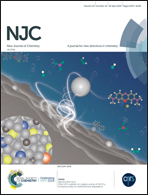Edge-oriented MoS2 supported on nickel/carbon core–shell nanospheres for enhanced hydrogen evolution reaction performance†
Abstract
Molybdenum disulfide (MoS2), as one of the important two-dimensional (2D) transition metal dichalcogenides (TMDs), has shown huge potential for catalytic applications. However, both poor conductivity and insufficient active edge sites are the main obstacles limiting MoS2 as a highly efficient electrocatalyst. In this study, a great number of edge-oriented 2D-MoS2 nanosheets were synthesized on the surface of nickel/carbon (Ni/C) core–shell spheres. The edge-oriented MoS2 nanosheets not only increase the number of exposed active edges, but also promote the charge transfer between active edges and Ni/C spheres. The electrochemical results show that nickel/carbon/MoS2 (Ni/C/MoS2) nanospheres deliver the highest activity with a Tafel slope as small as 55.5 mV per decade and an overpotential as small as 275 mV at a current density of 10 mA cm−2. Furthermore, this Ni/C/MoS2 core–shell architecture shows good stability and durability by the proof of 2000 cycles of cyclic voltammetry followed by a 9000 s i–t curve test. The method provides an opportunity to further improve the electrochemical catalysis of MoS2 to produce hydrogen for energy storage.



 Please wait while we load your content...
Please wait while we load your content...